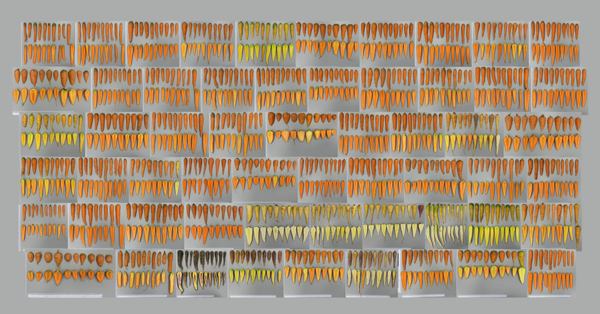The first results from a study to evaluate European carrot diversity have captured a wide range of genetic traits, in particular those of diverse landrace varieties. These traits could be of interest to breeders looking to increase the crop’s resilience to varying environmental conditions, including climate change.
The study, published in Acta Horticulturae, is part of the five-year work plan of the carrot group of the ECPGR European Evaluation Network (EVA)*, a collaboration of 14 partners from eight European countries including breeding companies, genebanks, universities and research institutes. EVA Carrot is one of five currently operating crop-specific EVA networks – the others being lettuce, maize, pepper, and wheat and barley, with another on grain legumes just starting their activities. The networks bring together public and private sector partners to generate standardized characterization and evaluation data on crop accessions present in European genebanks. At the moment, many of these accessions are often poorly characterized, limiting their potential for use in breeding programmes.
Over two years, the EVA Carrot network evaluated 60 landraces from four different genebanks, originating from 16 countries, including also appropriate controls. Analyzing phenotypic data from multilocation field trials in ten locations across Europe made it possible to estimate the influence of the environment on trait expression and variability. Three different genotyping approaches were deployed and showed comparable population structures, allowing selection of the most effective approaches in future applications. The results show that both environment and genetics affect phenotypic traits. For example, seven Spanish accessions showed a high tendency for bolting which is when root crops prematurely run to seed. When the trials took place in Italy and Spain, this tendency greatly reduced, suggesting that latitude rather than genetics affects bolting sensitivity as this tendency remained stable across different accessions. Analysis for foliar development, on the other hand, revealed that foliage width and volume diversity depended more on carrot type than origin as there was relative convergence between locations.
With more than 30 morphological and evaluation traits observed in the EVA carrot trials, these initial results capture a wide range of carrot genetic diversity and show that this diversity depends both on the accession and its interaction with the environment.
“As we dive into the data and continue our analyses, it's becoming clear that these early findings may be the foundation for a European carrot collection to save and share genetic diversity, especially from traditional landraces. This could be a key tool for breeders working to tackle the challenges of climate change in agriculture", said Sandra Goritschnig, EVA Coordinator and author of the study.
The study has also highlighted the need for increased seed availability and viability for accessions maintained in genebank collections, another important aim of the EVA Carrot project, which included also regeneration of around 30 carrot accessions for future evaluation.
Read:
- Exploring European Carrot Diversity Through Public-Private Partnerships in EVA Carrot
- Public-private partnership investigating European carrot genetic resources in EVA Carrot
*ECPGR European Evaluation Network (EVA) was established in 2019 with financial support from the German Federal Ministry of Food and Agriculture project GenRes2019-2.
